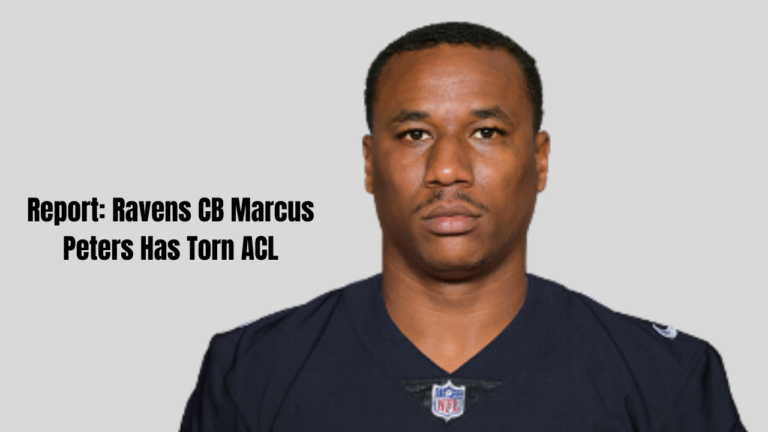Introduction to Marcus Peters’ Injury
Marcus Peters, a prominent cornerback for the Baltimore Ravens, has been a critical component of the team’s defensive strategy. report: ravens cb marcus peters has torn acl Renowned for his playmaking abilities and instincts on the field, Peters has consistently demonstrated exceptional skill in intercepting passes and defending against top-tier receivers. As a seasoned player in the National Football League (NFL), his experience has been invaluable for the Ravens, helping them maintain a competitive edge in critical matchups.
report: ravens cb marcus peters has torn acl The recent report detailing that Ravens cornerback Marcus Peters has torn his ACL has sent shockwaves throughout the organization and its fanbase. This injury not only raises concerns about Peters’ individual performance but also poses significant implications for the team’s overall defense. Before this unfortunate incident, Peters had been performing at a high level, contributing to the Ravens’ defensive successes and helping the team navigate through tough opponents this season.
In light of his injury, it is essential to evaluate the role that Peters plays within the Ravens’ framework. His capability to read the game and anticipate the opponent’s moves has allowed him to secure numerous pivotal interceptions, bolstering the Ravens’ defensive statistics. The expectation surrounding Peters was substantial ahead of the season, with many analysts predicting he would continue to be a dominant force in the secondary. The news of his torn ACL not only disrupts these projections but also raises questions about depth in the cornerback position for the remainder of the season.
As we delve deeper into the implications of this injury, it is crucial to consider both the immediate and long-term effects on both Marcus Peters and the Ravens’ defensive line-up moving forward.
Impact of the Injury on the Ravens’ Defense
The recent report indicating report: ravens cb marcus peters has torn acl that Ravens cornerback Marcus Peters has torn his ACL understandably raises significant concerns regarding the immediate and long-term impact on the team’s defensive capabilities. Peters, who has been a pivotal player within the Ravens’ defense, brings exceptional coverage skills and a commanding presence on the field. His absence will undoubtedly create a void that will require careful consideration by the coaching staff.
In the short term, the injury to Peters may necessitate a shift in defensive strategy. The Ravens’ coaching team may look to adjust their lineup, possibly promoting a backup cornerback from the roster. Players like Brandon Stephens or Arthur Maulet could be expected to take on increased responsibilities as they step into more prominent roles. Each of these players has displayed potential, yet the challenge lies in replacing the unique skill set Peters brought, particularly his ability to read plays and support the secondary’s overall coverage dynamics.
Long-term, the implications of Peters’ injury extend beyond immediate game strategy. As the season progresses, opposing offenses may exploit the newly assigned cornerbacks, potentially leading to increased passing yards against the Ravens. Peters’ statistics, which include key interceptions and forced turnovers, underscore his criticality to the defense; thus, his absence could diminish the effectiveness of both pass and run defense strategies. Furthermore, the leadership that Peters provided on the field cannot be understated—he was instrumental in motivating his teammates and coordinating defensive efforts.
As the Ravens prepare for upcoming games, the impact of Marcus Peters’ torn ACL will be profoundly felt. The coaching staff’s decisions regarding potential replacements and strategic adjustments will be crucial. Moving forward, it remains essential to monitor how these changes affect the Ravens’ overall defensive performance and whether they can adapt effectively in his absence.

Rehabilitation and Recovery Process
The recovery process following a torn anterior cruciate ligament (ACL) is complex and requires a well-structured approach tailored to the individual’s needs. In the case of Ravens cornerback Marcus Peters, who has been reported to have a torn ACL, the rehabilitation journey will likely consist of several stages, each focusing on restoring functionality and strength to the knee joint. Typically, the recovery period for professional athletes following an ACL tear can range from six to twelve months, depending on the severity of the injury and individual healing characteristics.
The initial phase post-injury often emphasizes reducing swelling and pain, which can involve rest, icing, compression, and elevation. Once inflammation is under control, physical therapists typically introduce range-of-motion exercises to help regain the knee’s flexibility. As healing progresses, strength training becomes a primary focus to rebuild the muscles surrounding the knee, often utilizing resistance bands and weight training. Toward the later stages of rehabilitation, Peters would need to participate in sport-specific drills designed to mirror game conditions, thereby preparing him for the demands of professional play.
Several factors influence the healing timeline, including the player’s age, overall health, and adherence to the rehabilitation program. Additionally, the role of medical professionals cannot be underestimated; they provide critical assessments and adjustments to the rehabilitation strategy based on Peters’ progress. A supportive recovery strategy that involves physical therapists, coaches, and family can significantly enhance motivation and accountability, both of which are vital for a successful return to competitive play. Ultimately, the key to recovering from a torn ACL is not only the commitment to rehabilitation but also a keen understanding of the need for adequate time to heal fully, ensuring that Peters can return to the field at optimal performance levels.
Fan Reaction and Future Outlook
The news regarding Ravens cornerback Marcus Peters’ torn ACL has sent ripples through both the fan base and the broader NFL community. Social media platforms have become a battleground for opinions, with many expressing disappointment over this significant injury. Peters has established himself as a crucial player within the Ravens’ defensive lineup, and his absence is felt deeply among supporters who had high hopes for the season. Fans are sharing their sentiments, with a mix of frustration and concern about how this injury will impact not only Peters’ career but also the overall performance of the Ravens moving forward.
Analysts have begun to report: ravens cb marcus peters has torn acl examine the potential implications of Peters’ torn ACL on the team’s season and playoff ambitions. Without such a key player in the secondary, the Ravens may face challenges in coverage and overall defensive cohesion. Predictions are varied; some believe that the team can regroup and find a way to adjust, while others worry that this injury may lead to a downturn in performance. The Ravens’ coaching staff will need to devise a strategy that maximizes the talents of their remaining players, as well as potentially integrate new talent into the roster to help fill the void left by Peters.
Looking forward, there remains a significant amount of uncertainty regarding Marcus Peters’ future with the team. Although he is expected to report: ravens cb marcus peters has torn acl undergo surgery for his torn ACL, the timeline for recovery will play a critical role in his return and adaptation to the game. It is plausible that, given the high stakes of professional football, the Ravens might also consider their long-term options at cornerback in light of this injury. Overall, the franchise’s direction may necessitate a reassessment of its defensive strategies to ensure competitiveness while awaiting Peters’ eventual return from injury.
May Be You Also Read

